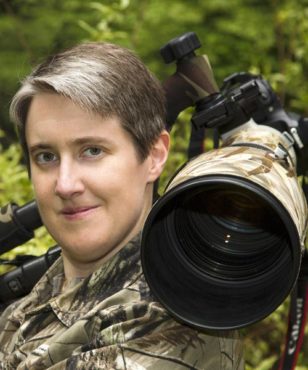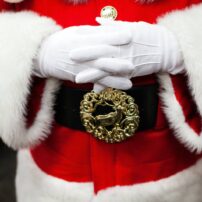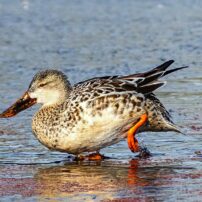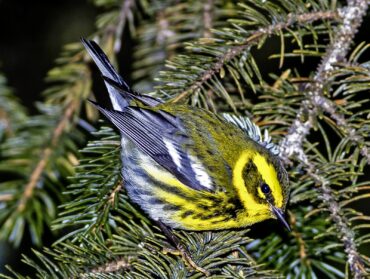
For many, a West Sound winter is a dreary time of year. Trees are devoid of leaves and flowers aren’t blooming. It’s cold, cloudy and often rainy. There is no perceived reason to venture outdoors. Just get cozy with a hot beverage and wait until spring to go outside. Unless you’re a birder.
Winter brings scores of birds to the region. From geese to gulls and ducks to dippers, a variety of birds abound in West Sound. Most birders focus on local waterways for winter birding, as dozens of waterfowl and seabird species come here to escape the Arctic cold.
While the region is not as known for songbird action this time of year as during the breeding season, there are some exceptions. Varied thrush and mixed sparrow flocks are delightful to watch. Flocks of chickadees, kinglets and nuthatches foraging in the trees may even host some winter warblers.
Of the eight warbler species that breed annually in West Sound, three are also found here in winter. Yellow-rumped, orange-crowned and Townsend’s warblers occasionally show up in winter, with more arriving in spring. The easiest way to spot them is to carefully search through mixed flocks of songbirds, as they forage in trees and shrubs. If there’s any flash of yellow, it’s likely a warbler or a kinglet. Warblers are slightly larger than kinglets and tend to be less energetic.
The easiest winter warbler to spot is the brightly colored Townsend’s warbler, named for naturalist John Kirk Townsend, who collected the first recognized specimen in Oregon in 1835. Unique among Puget Sound songbirds, the Townsend’s warbler is one of the few brilliantly colored birds that is found here outside of the breeding season.
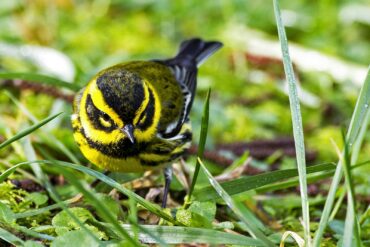
Offering a much-needed dose of cheerfulness on an otherwise gray day, the Townsend’s warbler, one of Washington’s most striking songbirds, is a real showstopper. The face has prominent, oversized, yellow goggles, which pop against a dark background that is black on males and olive green on females. As is typical with warblers, both the male and female Townsend’s warblers are very colorful. Although their appearance is similar, the olive-green body and streaked yellow underparts of the male are bolder than the paler female.
Like most warblers, the Townsend’s warbler is a migratory species, except in the Puget Sound region, where it inhabits mature coniferous and mixed forests year-round. Breeders travel as far north as eastern Alaska and British Columbia. In the nonbreeding season, migrants go as far south as Panama, with many also wintering along the Pacific Coast.
While it can be found in a variety of woodland habitat during migration, in Western Washington, the Townsend’s warbler prefers old-growth forest. But since that is getting harder to come by, it’s also found in mature forests, particularly those with tall fir, spruce and hemlock. The Townsend’s warbler is usually detected by its buzzy, multinote calls, which have a different rhythm from the black-throated gray warbler’s similar sound.
Small groups tend to forage high in the trees, as they glean fir needles for insects and larvae. Their diet is supplemented with spiders, seeds and occasionally suet from backyard feeders. Sometimes coastal windstorms knock seeds from coniferous trees, which can bring droves of Townsend’s warblers to the ground, offering a rare visual treat for birders. The campground of Cape Disappointment State Park near Ilwaco, Pacific County, is possibly the best-known place for this winter spectacle.
Males establish their breeding territories before pairing up with females. The nest site is carefully chosen by the female, who builds a bulky cup of bark, twigs, moss, lichen, grass and hair near the end of a hidden fir branch, usually 36 feet above ground level. Sometimes she moves her nest materials from one spot and finishes it in a more suitable location.
The pair raises one brood per year. The female incubates the clutch of three to seven eggs for up to two weeks. Both parents tend to the nestlings, who fledge after 10 or 11 days.
The Townsend’s warbler sometimes hybridizes with the similar hermit warbler, a species that relies on mature, montane forests. In Washington, the hybrid zones include parts of the Olympics and southern Cascade Mountains. In some places, the more aggressive Townsend’s warbler is displacing the less aggressive hermit warbler.
While the Townsend’s warbler population is stable, hybridization with the hermit warbler is contributing to its cousin’s decline. This is largely due to the substantial loss of old-growth forest, where the hermit warbler prefers to live. Although it’s also susceptible to habitat loss, the Townsend’s warbler can thrive in lower- and mid-elevation coniferous forests.
Sometimes little things are enough to get you through a dreary day. So, scan the treetops or carefully sort through a flock of songbirds. A colorful Townsend’s warbler may be there to brighten the day.




